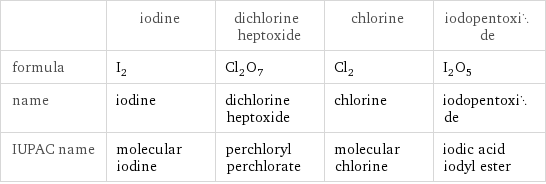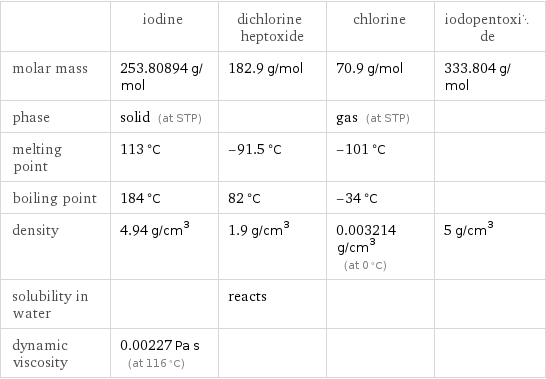Input interpretation

I_2 iodine + Cl_2O_7 dichlorine heptoxide ⟶ Cl_2 chlorine + I_2O_5 iodopentoxide
Balanced equation

Balance the chemical equation algebraically: I_2 + Cl_2O_7 ⟶ Cl_2 + I_2O_5 Add stoichiometric coefficients, c_i, to the reactants and products: c_1 I_2 + c_2 Cl_2O_7 ⟶ c_3 Cl_2 + c_4 I_2O_5 Set the number of atoms in the reactants equal to the number of atoms in the products for I, Cl and O: I: | 2 c_1 = 2 c_4 Cl: | 2 c_2 = 2 c_3 O: | 7 c_2 = 5 c_4 Since the coefficients are relative quantities and underdetermined, choose a coefficient to set arbitrarily. To keep the coefficients small, the arbitrary value is ordinarily one. For instance, set c_2 = 1 and solve the system of equations for the remaining coefficients: c_1 = 7/5 c_2 = 1 c_3 = 1 c_4 = 7/5 Multiply by the least common denominator, 5, to eliminate fractional coefficients: c_1 = 7 c_2 = 5 c_3 = 5 c_4 = 7 Substitute the coefficients into the chemical reaction to obtain the balanced equation: Answer: | | 7 I_2 + 5 Cl_2O_7 ⟶ 5 Cl_2 + 7 I_2O_5
Structures

+ ⟶ +
Names

iodine + dichlorine heptoxide ⟶ chlorine + iodopentoxide
Equilibrium constant
![Construct the equilibrium constant, K, expression for: I_2 + Cl_2O_7 ⟶ Cl_2 + I_2O_5 Plan: • Balance the chemical equation. • Determine the stoichiometric numbers. • Assemble the activity expression for each chemical species. • Use the activity expressions to build the equilibrium constant expression. Write the balanced chemical equation: 7 I_2 + 5 Cl_2O_7 ⟶ 5 Cl_2 + 7 I_2O_5 Assign stoichiometric numbers, ν_i, using the stoichiometric coefficients, c_i, from the balanced chemical equation in the following manner: ν_i = -c_i for reactants and ν_i = c_i for products: chemical species | c_i | ν_i I_2 | 7 | -7 Cl_2O_7 | 5 | -5 Cl_2 | 5 | 5 I_2O_5 | 7 | 7 Assemble the activity expressions accounting for the state of matter and ν_i: chemical species | c_i | ν_i | activity expression I_2 | 7 | -7 | ([I2])^(-7) Cl_2O_7 | 5 | -5 | ([Cl2O7])^(-5) Cl_2 | 5 | 5 | ([Cl2])^5 I_2O_5 | 7 | 7 | ([I2O5])^7 The equilibrium constant symbol in the concentration basis is: K_c Mulitply the activity expressions to arrive at the K_c expression: Answer: | | K_c = ([I2])^(-7) ([Cl2O7])^(-5) ([Cl2])^5 ([I2O5])^7 = (([Cl2])^5 ([I2O5])^7)/(([I2])^7 ([Cl2O7])^5)](../image_source/8ada0dfa5e3b364644832fb4bbaf2401.png)
Construct the equilibrium constant, K, expression for: I_2 + Cl_2O_7 ⟶ Cl_2 + I_2O_5 Plan: • Balance the chemical equation. • Determine the stoichiometric numbers. • Assemble the activity expression for each chemical species. • Use the activity expressions to build the equilibrium constant expression. Write the balanced chemical equation: 7 I_2 + 5 Cl_2O_7 ⟶ 5 Cl_2 + 7 I_2O_5 Assign stoichiometric numbers, ν_i, using the stoichiometric coefficients, c_i, from the balanced chemical equation in the following manner: ν_i = -c_i for reactants and ν_i = c_i for products: chemical species | c_i | ν_i I_2 | 7 | -7 Cl_2O_7 | 5 | -5 Cl_2 | 5 | 5 I_2O_5 | 7 | 7 Assemble the activity expressions accounting for the state of matter and ν_i: chemical species | c_i | ν_i | activity expression I_2 | 7 | -7 | ([I2])^(-7) Cl_2O_7 | 5 | -5 | ([Cl2O7])^(-5) Cl_2 | 5 | 5 | ([Cl2])^5 I_2O_5 | 7 | 7 | ([I2O5])^7 The equilibrium constant symbol in the concentration basis is: K_c Mulitply the activity expressions to arrive at the K_c expression: Answer: | | K_c = ([I2])^(-7) ([Cl2O7])^(-5) ([Cl2])^5 ([I2O5])^7 = (([Cl2])^5 ([I2O5])^7)/(([I2])^7 ([Cl2O7])^5)
Rate of reaction
![Construct the rate of reaction expression for: I_2 + Cl_2O_7 ⟶ Cl_2 + I_2O_5 Plan: • Balance the chemical equation. • Determine the stoichiometric numbers. • Assemble the rate term for each chemical species. • Write the rate of reaction expression. Write the balanced chemical equation: 7 I_2 + 5 Cl_2O_7 ⟶ 5 Cl_2 + 7 I_2O_5 Assign stoichiometric numbers, ν_i, using the stoichiometric coefficients, c_i, from the balanced chemical equation in the following manner: ν_i = -c_i for reactants and ν_i = c_i for products: chemical species | c_i | ν_i I_2 | 7 | -7 Cl_2O_7 | 5 | -5 Cl_2 | 5 | 5 I_2O_5 | 7 | 7 The rate term for each chemical species, B_i, is 1/ν_i(Δ[B_i])/(Δt) where [B_i] is the amount concentration and t is time: chemical species | c_i | ν_i | rate term I_2 | 7 | -7 | -1/7 (Δ[I2])/(Δt) Cl_2O_7 | 5 | -5 | -1/5 (Δ[Cl2O7])/(Δt) Cl_2 | 5 | 5 | 1/5 (Δ[Cl2])/(Δt) I_2O_5 | 7 | 7 | 1/7 (Δ[I2O5])/(Δt) (for infinitesimal rate of change, replace Δ with d) Set the rate terms equal to each other to arrive at the rate expression: Answer: | | rate = -1/7 (Δ[I2])/(Δt) = -1/5 (Δ[Cl2O7])/(Δt) = 1/5 (Δ[Cl2])/(Δt) = 1/7 (Δ[I2O5])/(Δt) (assuming constant volume and no accumulation of intermediates or side products)](../image_source/31140561b4b1ceb18edbbbc185689b47.png)
Construct the rate of reaction expression for: I_2 + Cl_2O_7 ⟶ Cl_2 + I_2O_5 Plan: • Balance the chemical equation. • Determine the stoichiometric numbers. • Assemble the rate term for each chemical species. • Write the rate of reaction expression. Write the balanced chemical equation: 7 I_2 + 5 Cl_2O_7 ⟶ 5 Cl_2 + 7 I_2O_5 Assign stoichiometric numbers, ν_i, using the stoichiometric coefficients, c_i, from the balanced chemical equation in the following manner: ν_i = -c_i for reactants and ν_i = c_i for products: chemical species | c_i | ν_i I_2 | 7 | -7 Cl_2O_7 | 5 | -5 Cl_2 | 5 | 5 I_2O_5 | 7 | 7 The rate term for each chemical species, B_i, is 1/ν_i(Δ[B_i])/(Δt) where [B_i] is the amount concentration and t is time: chemical species | c_i | ν_i | rate term I_2 | 7 | -7 | -1/7 (Δ[I2])/(Δt) Cl_2O_7 | 5 | -5 | -1/5 (Δ[Cl2O7])/(Δt) Cl_2 | 5 | 5 | 1/5 (Δ[Cl2])/(Δt) I_2O_5 | 7 | 7 | 1/7 (Δ[I2O5])/(Δt) (for infinitesimal rate of change, replace Δ with d) Set the rate terms equal to each other to arrive at the rate expression: Answer: | | rate = -1/7 (Δ[I2])/(Δt) = -1/5 (Δ[Cl2O7])/(Δt) = 1/5 (Δ[Cl2])/(Δt) = 1/7 (Δ[I2O5])/(Δt) (assuming constant volume and no accumulation of intermediates or side products)
Chemical names and formulas

| iodine | dichlorine heptoxide | chlorine | iodopentoxide formula | I_2 | Cl_2O_7 | Cl_2 | I_2O_5 name | iodine | dichlorine heptoxide | chlorine | iodopentoxide IUPAC name | molecular iodine | perchloryl perchlorate | molecular chlorine | iodic acid iodyl ester
Substance properties

| iodine | dichlorine heptoxide | chlorine | iodopentoxide molar mass | 253.80894 g/mol | 182.9 g/mol | 70.9 g/mol | 333.804 g/mol phase | solid (at STP) | | gas (at STP) | melting point | 113 °C | -91.5 °C | -101 °C | boiling point | 184 °C | 82 °C | -34 °C | density | 4.94 g/cm^3 | 1.9 g/cm^3 | 0.003214 g/cm^3 (at 0 °C) | 5 g/cm^3 solubility in water | | reacts | | dynamic viscosity | 0.00227 Pa s (at 116 °C) | | |
Units
